|
| moonstruck |
|
| The origin of the Moon is still a subject of some scientific debate, but the most accepted theory holds that it was formed of the debris from a massive collision with the young Earth about 4.6 billion years ago. A huge body, perhaps the size of Mars, struck the Earth, throwing out an immense amount of debris that coalesced and cooled in orbit around the Earth. The Moon makes one rotation and completes a revolution around the Earth every 29 days, 12 hours, 44 minutes, and 2.78 seconds. This synchronous rotation is caused by an uneven distribution of mass in the Moon (essentially, it is "heavier" on one side than the other), and has allowed the Earth's gravity to keep one side of the Moon permanently facing Earth. The Moon is at an average distance from Earth of 384,403 km (238,857 mi). |
|
|
|
| In order to be to be synchronized with the Moon and maintain a correct display, the little moon disk on wristwatches has to complete one turn in 29 days, 12 hours, 44 minutes, and 2.78 seconds. In spite of that obvious challenge, just about every watch company has at least one watch with moonphase display. Many, including Glashütte Original, have several models. Seen here are the Karree Ewiger Kalender , the Senator Panoramadatum, and the 1845 Ewiger Kalender. Obviously, Glashütte Original has shed the ideology that dominated what used to be East Germany, because there is nothing socialist about these belles. |
|
|
|
| There were a total of nine Apollo missions launched, six of which landed on the Moon: Apollo 8 (launched 21 December 1968, lunar orbit and return, returned to Earth 27 December 1968); Apollo 10 (launched 18 May 1969, lunar orbit and return, returned to Earth 26 May 1969); Apollo 11 (launched 16 July 1969, landed on Moon 20 July 1969 - Sea of Tranquility, returned to Earth 24 July 1969); Apollo 12 (launched 14 November 1969, landed on Moon 19 November 1969 - Sea of Storms, returned to Earth 24 November 1969); Apollo 13 (launched 11 April 1970, lunar flyby and return - malfunction forced cancellation of lunar landing, returned to Earth 17 April 1970); Apollo 14 (launched 31 January 1971, landed on Moon 5 February 1971 - Fra Mauro, returned to Earth 9 February 1971); Apollo 15 (launched 26 July 1971, landed on Moon 30 July 1971 - Hadley Rille, returned to Earth 7 August 1971); Apollo 16 (launched 16 April 1972, landed on Moon 20 April 1972 - Descartes, returned to Earth 27 April 1972); Apollo 17 (launched 07 December 1972, landed on Moon 11 December 1972 - Taurus-Littrow, returned to Earth 19 December 1972). |
| With price tags ranging between $6,500 and $180,000, Roger Dubuis watches have nothing as flashy as diamond-encrusted, heavily bejeweled cases with solid gold bracelets. The 58 year-old master watchmaker, who before founding his eponymous company used to be the master of complications at Patek Philippe, just produces elaborate timepieces on leather straps. Working in partnership with Carlos Dias, a Portuguese who made his fortune in ready-to-wear Italian clothes, Mr. Dubuis designs only mechanical watches. From each design - of which there are about 70 - only 28 pieces will be made. |
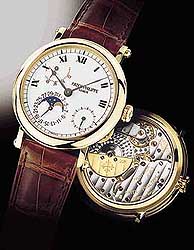 |
The dean of luxury watchmakers, Patek Philippe, established in 1839, reaffirmed its confidence in Geneva by investing $90 million in a new factory last year. Considered among many watch lovers to be the world's most respected brand, Patek Philippe manufactures just 20,000 pieces a year and has a turnover of about 200 million Swiss francs ($143 million). "The secrets of success are to add value constantly and to ensure that supply does not outstrip demand," says Philippe Stern, president of the company. "We make all the movements ourselves. That is how we can add value and innovate," he adds. "Others cannot match our quality because they do not have full control over production." | 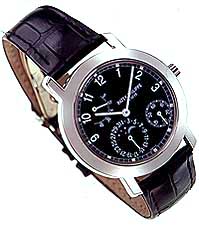 |
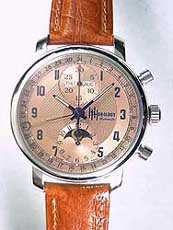 |
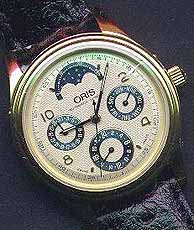 |
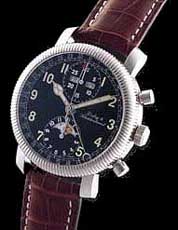 |
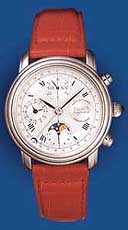 |
| If the plane of Earth's orbit around the Sun (the ecliptic) and the plane of the Moon's orbit around Earth were the same, the Moon would be eclipsed by Earth every time it is full, and the Sun would be eclipsed by the Moon every time the Moon is "new." However, because the two orbits do not coincide, the Moon's shadow normally misses Earth and Earth's shadow misses the Moon. The inclination of the two orbital planes to each other is 5°. |
| Below, on the left, is a Breguet pocket watch with moonphase, even more elegant in appearance than the company's wristwatches! On the right, the Space Traveller's Watch by George Daniels, the winner of many national and international awards, including the prestigious Tompion Gold Medal, and one of the greatest living horlogists, the one who invented the co-axial escapement that is now being marketed by Omega. |
| Space Traveller's Watch displays Sideral Time with inset age and phase of the moon, Mean Solar Time with inset date of the month, seconds below, equation of time sector above, gold solar hands, blue steel sideral hands, chronograph hand indicated either Solar or Sideral seconds to choice, Solar:Sideral ratio 1:1.002737924 Rapid setting for all displays, both trains with independant stop-start for precise setting of seconds. The watch, made to commemorate the American landing on the moon, was completed in 1983. |
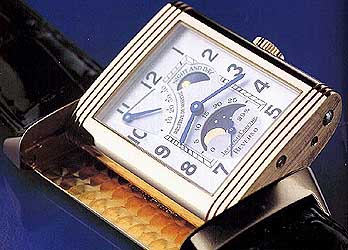 |
The tides are, of course, caused by the Moon with the help of the Sun, but in the open ocean they are surprisingly low, amounting to about one yard. The very high tides that can be observed near the shore in some places are due to funneling effects of the shorelines. At new moon and at full moon the tides raised by the Moon are reinforced by the Sun; these are the "spring tides." If the Sun's tidal power acts at right angles to that of the Moon (quarter moons) we get the low "neap tides." | 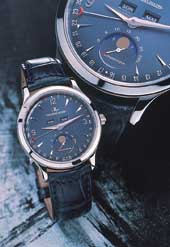 |
|
| Page 1: hello |
Page 2: nice things |
Page 3: Audemars Piguet |
Page 4: IWC, JLC |
Page 5: Patek Philippe |
| Page 6: Flieger |
Page 7: more Flieger |
Page 8: Zenith, Eberhard |
Page 9: chronographs |
Page 10: big money! |
| Page 11: mo' money |
Page 12:
more chronos |
Page 13: less known gems |
Page 14: moonstruck |
Page 15: pictures & links |